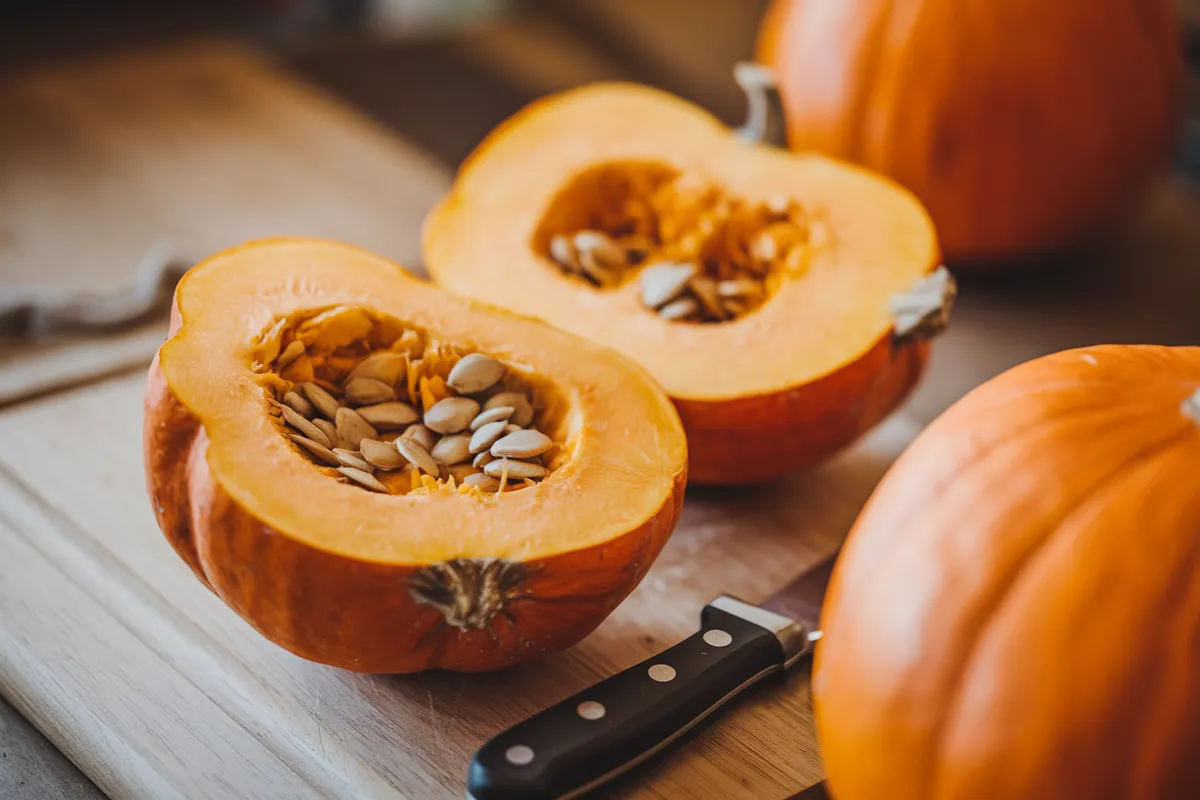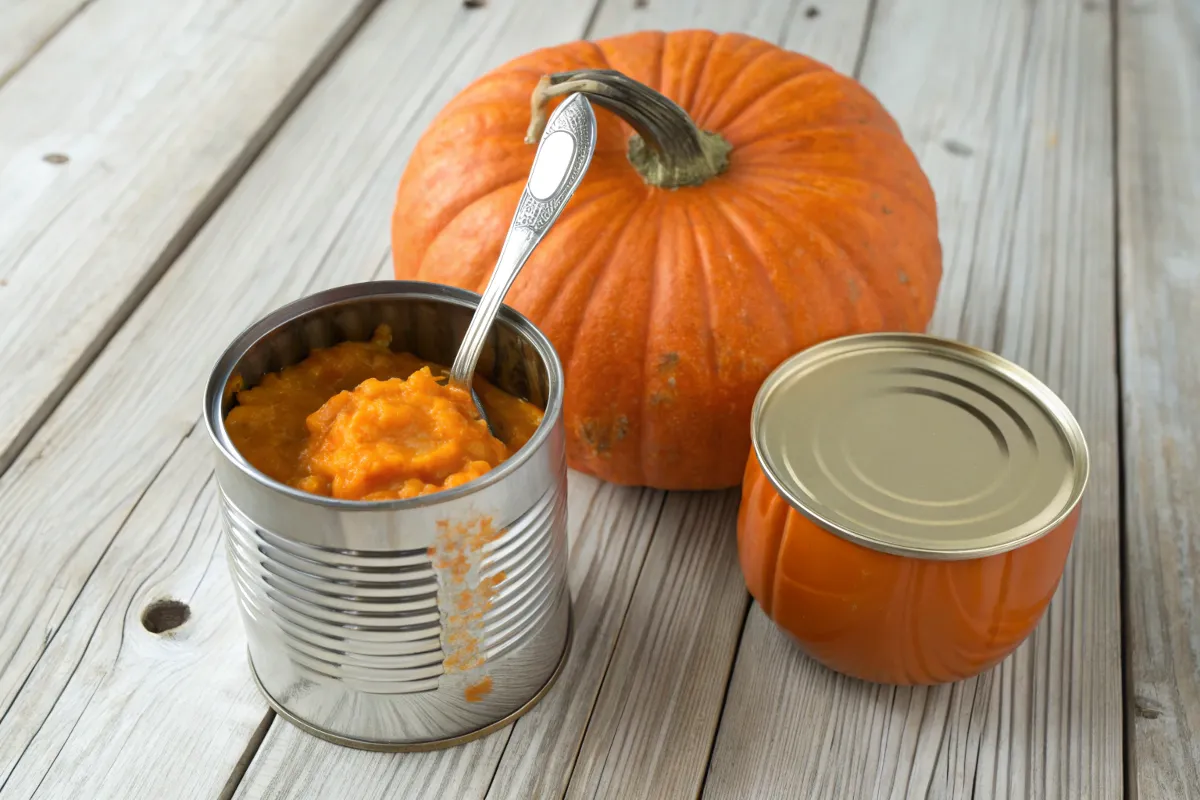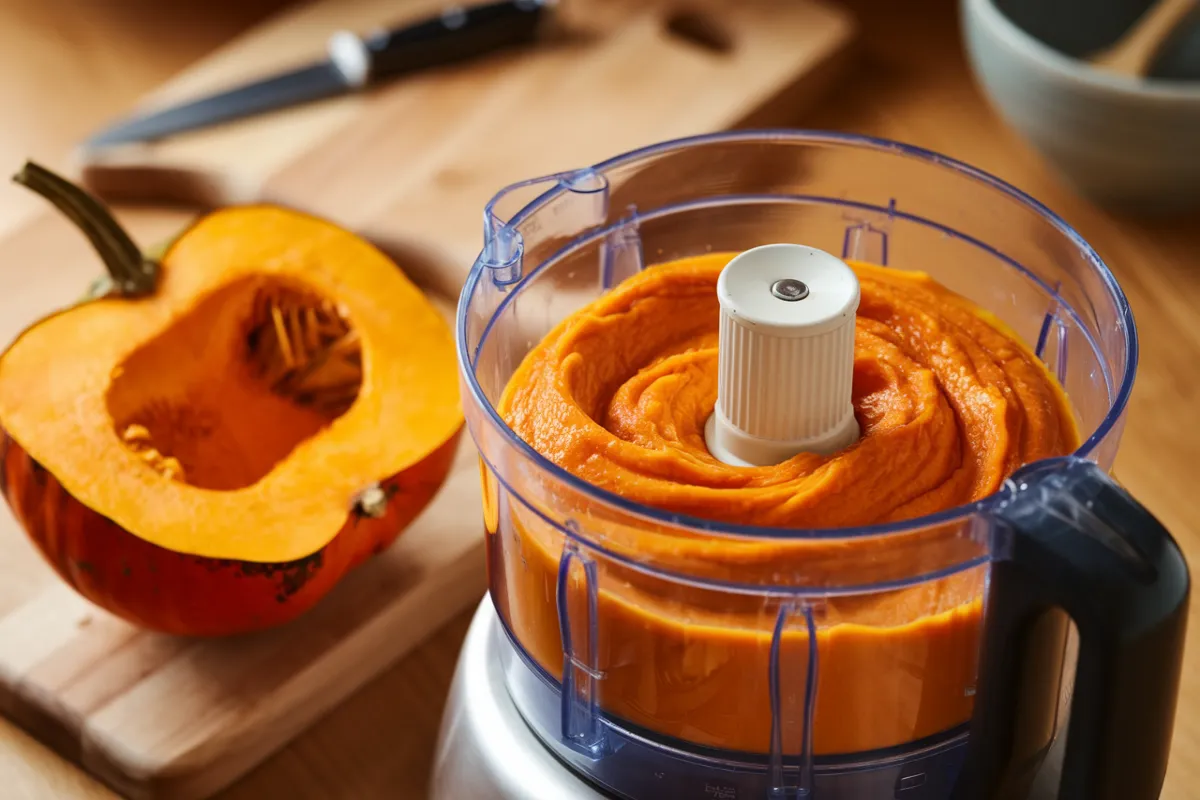This article explores whether you can use fresh pumpkin instead of canned pumpkin in your recipes. We’ll cover the differences, the best types of pumpkins, and how to make the switch.
Understanding Using Fresh Pumpkin Instead of Canned Pumpkin
Many bakers wonder, can I use fresh pumpkin instead of canned pumpkin? The answer is yes, absolutely! Using fresh pumpkin can add amazing flavor to your dishes. However, there are some key differences. Canned pumpkin is convenient. It’s already cooked and pureed. Fresh pumpkin, conversely, requires a bit more work. In this article, we’ll explore all the important details for using both.
The Appeal of Fresh Pumpkin
Using fresh pumpkin offers a unique flavor profile that is often described as brighter and more nuanced. It avoids the often-metallic taste that some people find with canned pumpkin. Additionally, you control the entire process. Furthermore, you know exactly what is in your puree. This can be especially attractive to those who prefer natural, unprocessed foods. Finally, cooking with fresh pumpkin connects you with the season’s bounty. The journey of turning a whole pumpkin into a delicious ingredient is very rewarding. It’s a chance to slow down and appreciate the natural process. This can also offer a satisfying experience beyond the taste.
The Convenience of Canned Pumpkin
Canned pumpkin is extremely convenient. It’s pre-cooked and pureed. This saves a lot of time and effort in the kitchen. Furthermore, it is available year-round. This makes it a reliable choice for many bakers. Canned pumpkin is also very consistent. Each can has a similar texture and moisture level. This is key when baking. The consistent nature of canned pumpkin ensures predictable results. Therefore, it is favored for recipes where precision is important. Moreover, its availability regardless of the season makes it an indispensable pantry staple.
Key Differences Between Fresh Pumpkin and Canned Pumpkin
Although both come from pumpkins, they are not the same. Fresh pumpkin and canned pumpkin differ significantly in several areas. Let’s explore these key differences:
Water Content
-
Fresh pumpkin generally has a higher water content. Therefore, it might produce a thinner puree. This can alter the final product in baking, as you may need to adjust the liquids in your recipe. Consequently, it might require additional steps. The amount of water in fresh pumpkin can fluctuate based on growing conditions and pumpkin variety. Thus, bakers must always be mindful when using fresh pumpkin.
-
Canned pumpkin, conversely, typically has a lower water content. It undergoes processing that removes excess moisture. Consequently, this results in a thicker, denser product. The controlled processing of canned pumpkin gives it a very predictable consistency. As a result, it is a dependable ingredient for recipes with specific texture targets.
Flavor
-
Fresh pumpkin, as noted earlier, often delivers a brighter, fresher taste. Therefore, it will impart a more complex, nuanced flavor to your dish. This is especially noticeable in simpler recipes, where the pumpkin flavor shines through. The unique notes in fresh pumpkin often have an earthy sweetness. Accordingly, it adds a touch of sophistication to your creations.
-
Canned pumpkin generally has a more muted, sometimes metallic, taste. This is due to the processing methods used to preserve the product. While convenient, canned pumpkin’s processing can cause some loss in natural flavor. However, many find its taste is a familiar and comforting one.
Texture
-
Fresh pumpkin can vary quite a bit in texture depending on the specific variety and cooking method. Some varieties result in a smooth puree. However, others might be more fibrous. The texture of fresh pumpkin can even change based on how it is prepared. Therefore, it’s important to consider the best method.
-
Canned pumpkin has a consistent, smooth texture. This is advantageous in baking. Therefore, it ensures the outcome is uniform each time. The consistent texture of canned pumpkin greatly reduces the risk of uneven baking. Furthermore, it is easier to work with for many home cooks.
Preparation Time
-
Preparing fresh pumpkin takes significantly more time. It involves washing, cutting, seeding, roasting, and pureeing. This adds preparation time to your recipe. The time spent preparing fresh pumpkin is worthwhile if you desire its unique taste. However, it requires careful planning.
-
Canned pumpkin, in comparison, is ready to use straight from the can. It saves a substantial amount of time. It also requires no preparation work. The quick convenience of canned pumpkin appeals to those who have busy schedules. Consequently, it’s a practical option for many.
How to Use Fresh Pumpkin Instead of Canned Pumpkin
So, can I use fresh pumpkin instead of canned pumpkin? Yes, you can! Here is a step-by-step guide:
Selecting the Right Pumpkin
Not all pumpkins are created equal. Therefore, some are better for cooking than others. Choose smaller, denser pumpkins called sugar or pie pumpkins. Avoid large Jack-O’-Lantern pumpkins, as they have a stringy texture and watery flavor. Furthermore, their flesh is not as sweet. These smaller pumpkins are designed for flavor and texture. Therefore, they are best for baking and cooking. Pie pumpkins are also easier to handle due to their size and density. Accordingly, they are a more user-friendly option.
Preparing Fresh Pumpkin
-
Wash and Cut: Wash your pumpkin thoroughly. Cut it in half. Afterward, scoop out the seeds and stringy pulp. The process of cleaning the pumpkin is important for the taste of the final product. Therefore, take the time to remove the strings and pulp fully.
-
Roast: Place the pumpkin halves, cut-side up, on a baking sheet. Add a little water to the sheet. Then, roast at 375°F (190°C) until the flesh is very soft (about 45–60 minutes). The exact time depends on size and variety. The roasting process softens the pumpkin flesh and brings out the natural sweetness. Thus, it makes pureeing easier.
-
Puree: Once cooled, scoop the cooked flesh from the skin. Puree it in a food processor or blender until smooth. The blending process should yield a smooth and creamy texture, free of lumps. Afterward, you’ll be ready to use it in your chosen recipe.
Adjusting for Water Content When Using Fresh Pumpkin
As previously stated, fresh pumpkin puree can have higher water content. Therefore, you may need to drain the puree. Place it in a cheesecloth-lined colander. Let it sit for an hour or two. This will remove the excess water. After that, you can use it for baking. Alternatively, consider adding a small amount of flour to your recipe if you don’t drain. However, this will change the consistency of the recipe slightly. Adjusting for water content is a key step in using fresh pumpkin successfully. Accordingly, it is important to keep this in mind.
Using Fresh Pumpkin in Recipes
Once your fresh pumpkin is pureed and drained, it’s ready to use. For the most part, you can substitute it 1:1 for canned pumpkin. However, keep in mind the potential differences in moisture level. Adjust other liquids or thickeners in your recipes as needed. Always taste as you go to ensure the flavor is just right. Remember that baking is both art and science. Consequently, it’s important to adapt recipes as needed.
Recipes Where You Can Use Fresh Pumpkin Instead of Canned
Using fresh pumpkin instead of canned pumpkin can enhance many recipes. Here are some ideas:
Pumpkin Pie
Fresh pumpkin in pumpkin pie offers a brighter, more vibrant flavor. However, remember to drain any excess moisture to prevent a soggy crust. Fresh pumpkin will give your pie a homemade quality that is truly special. The enhanced flavor profile of fresh pumpkin makes this classic pie even better. Consequently, it is worth the effort of using it.
Pumpkin Bread
Similarly, using fresh pumpkin in pumpkin bread results in a more flavorful, moist loaf. Furthermore, it can also result in a better color as compared to canned pumpkin. If the puree is too wet, then you might need to add a bit more flour. The natural sweetness of fresh pumpkin also reduces the need for added sugars. As a result, you get a healthier product.
Pumpkin Soup
In pumpkin soup, fresh pumpkin provides a richer, more natural taste. Roasting the pumpkin before pureeing intensifies its flavor. Thus, it makes the soup even more delicious. Roasting the pumpkin gives the soup a depth of flavor. Therefore, it makes the soup even more flavorful.
Pumpkin Muffins
When you use fresh pumpkin in muffins in muffins, you create a more flavorful breakfast treat. Additionally, it imparts a beautiful color to the muffins. They are delightful whether you have them as a breakfast or dessert. The added taste and texture of fresh pumpkin make these muffins stand out. As a result, they are a favorite of many.
Pumpkin Pancakes
Using fresh pumpkin for your pumpkin pancakes results in a breakfast with more natural flavors. Therefore, it will make your morning a little better. Just be sure to add enough liquid so the batter isn’t too thick. The subtle sweetness and vibrant color of fresh pumpkin enhance these pancakes. They are very different from their canned counterparts.
Can I use fresh pumpkin instead of canned pumpkin? – Key Considerations
Before you swap, consider the following points:
Time Commitment
Preparing fresh pumpkin is time-consuming. If you are short on time, canned pumpkin is the better option. Furthermore, you need to dedicate adequate time to the entire process to make the substitution work. The process can be both fulfilling and time intensive. Therefore, it’s important to evaluate the value of this process.
Consistency
-
Canned pumpkin is reliable. Its consistency is the same from one can to the next. Conversely, fresh pumpkin can vary. It is very dependent on variety and preparation methods. Consistent results can be important in complex recipes. Therefore, canned pumpkin can be a very helpful option.
-
This can be either positive or negative. Therefore, keep this in mind when deciding. The variability of fresh pumpkin can lead to fun, unpredictable outcomes. However, it is also a great lesson for new cooks.
Flavor Preference
-
Fresh pumpkin offers a fresher, more complex flavor. However, not everyone prefers this over the more subtle flavor of canned pumpkin. Therefore, it all comes down to personal taste. Taste is subjective. Therefore, it is important to try both to see which one you like best.
-
Taste both options to determine which flavor you like the best. Personal preferences can play a big role in your choice. Consequently, it is very important to try both ways.
Availability
-
Canned pumpkin is available year-round. However, fresh pumpkin is seasonal. Consequently, fresh pumpkin is only available during the fall. This can be a major factor when choosing. The seasonal nature of fresh pumpkin makes it more special. Therefore, try to get it when it’s available.
Additional Tips for Using Fresh Pumpkin
Let’s delve deeper into some tips to help you get the best results when using fresh pumpkin:
Experimenting with Pumpkin Varieties
Exploring different pumpkin varieties can be fun. Each one has its own distinct taste and texture. For example, the Kabocha pumpkin is known for its dense, sweet flesh. Therefore, it’s perfect for baking. Likewise, the Long Island Cheese pumpkin also has a unique flavor and texture profile. Try out different options to find the one that suits your preference.
Roasting vs. Steaming
While roasting is a popular method for preparing fresh pumpkin, steaming is also a viable option. Steaming retains more moisture. However, the flavor is not as intense as roasting. Experiment to find out which method you prefer for a specific recipe. Each method offers its own set of advantages. Consequently, it’s good to experiment and learn each approach.
Adding Spices
Spices play a key role in bringing out the best flavor in pumpkin. Cinnamon, nutmeg, ginger, and cloves are classic choices. Feel free to add your own blends. However, be aware of how much you are adding, because spices can overpower the fresh pumpkin flavor. Experiment with different combinations to enhance your recipes.
Storing Fresh Pumpkin Puree
-
Fresh pumpkin puree can be stored in the refrigerator for 3-4 days. It can be frozen for up to 3 months. To freeze it, store it in airtight containers or freezer bags. This way, you can enjoy the benefits of fresh pumpkin for a long time.
-
When you are ready to use it, thaw it in the refrigerator overnight. If needed, drain off excess liquid before using. This ensures the quality and consistency.
Using Pumpkin Seeds
Don’t discard the pumpkin seeds! They can be roasted for a healthy snack. Toss them with a little oil and salt. Then, roast them in the oven until crisp. They make a delicious and nutritious addition to salads or simply on their own. Roasting pumpkin seeds is a great way to reduce waste. Also, it adds another layer of cooking possibilities.
Exploring Other Applications of Fresh Pumpkin
Besides baked goods, fresh pumpkin has a lot of other uses. Here are a few ideas:
Pumpkin Hummus
Blend cooked fresh pumpkin with chickpeas, tahini, garlic, and lemon juice. This creates a delicious and healthy dip. It can be a great alternative to traditional hummus. Therefore, it adds a unique flavor to this popular dip.
Pumpkin Risotto
Add fresh pumpkin puree to risotto for a creamy, flavorful dish. This is a great way to showcase the subtle flavors of fresh pumpkin. Thus, it creates a savory, comforting dish.
Pumpkin Smoothies
Blend fresh pumpkin puree with yogurt, milk, and your choice of fruit. This is a quick and easy way to incorporate fresh pumpkin into your diet. It makes for a delicious and nutritious snack or breakfast.
Pumpkin Butter
Simmer fresh pumpkin puree with spices, sugar, and a little lemon juice. This will create a delicious pumpkin butter that is great on toast or biscuits. This can be a very versatile addition to your kitchen. It can also be a unique homemade gift.
Savory Pumpkin Dishes
Fresh pumpkin can also be incorporated into savory dishes. Try it in pasta sauces, stews, or curries. It provides a natural sweetness and creamy texture to these meals. This also makes your meals more nutritious.
Frequently Asked Questions (FAQs)
How much fresh pumpkin equals a can of pumpkin?
Generally, one 15-ounce can of canned pumpkin equals about 1 ¾ cups of fresh pumpkin puree. However, you might want to drain the fresh pumpkin puree. This will help ensure that the consistency is correct.
What is the difference between canned pumpkin and fresh pumpkin?
Canned pumpkin is pre-cooked, pureed, and has a consistent texture and flavor. It is also readily available year-round. Fresh pumpkin needs more preparation. However, it has a brighter, more natural flavor. Also, fresh pumpkin has a higher water content. It can also have a varying texture depending on the type of pumpkin.
Can you use regular pumpkins for pumpkin pie?
While it’s possible, regular Jack-O’-Lantern pumpkins are not ideal for pumpkin pie. They have a stringy texture. Furthermore, they also have a watery, bland flavor. Sugar pumpkins, also known as pie pumpkins, are better for cooking. Because they have denser, sweeter flesh, they’re the ideal choice for pies.
What is the best pumpkin for baking?
The best pumpkins for baking are sugar pumpkins, also called pie pumpkins. These smaller pumpkins have a sweet taste and a dense, smooth texture. Therefore, they are well suited for all kinds of baking. They produce great-tasting baked goods.
Conclusion
So, can I use fresh pumpkin instead of canned pumpkin? Yes, you can absolutely use fresh pumpkin instead of canned pumpkin. The key is to understand the differences and adjust as needed. Fresh pumpkin offers a delightful, natural flavor, that can transform your dishes. Using fresh pumpkin can also be a fun, fulfilling culinary experience. Consider trying it in your next recipe! Additionally, it can add a new level of flavor to your favorite pumpkin recipes. Experiment with different methods and recipes to find your personal preference. Enjoy the process of transforming a fresh pumpkin into a variety of dishes.




